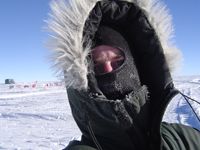Land, sea, air, and space
Posted: October 21, 2009
High flying, globe-trotting Air Force physician is ready for the unexpected As Chief of Aerospace Medicine for the 13 AF, Maj. Gregory Richert has a job that is seemingly straight out of the movies – one that includes traveling across the globe, daring rescues, and frequent medical missions into the desolate continent of Antarctica. “My job truly is a dream,” he says. “I practice more medicine in other countries than in America at this point. I’ve had the opportunity to see and work in nearly every major country in Asia, am sent all over the world as a subject matter expert on austere and combat medicine, spend weeks in New Zealand, execute high-risk rescues in Antarctica that involve multiple countries, and treat or help treat thousands of people.” A 2003 graduate of ATSU’s Kirksville College of Osteopathic Medicine, Maj. Richert’s life is far removed from the plains of Missouri. He keeps a home in Hawaii and spends most of his time at work in exotic locales including Vietnam, the Philippines, and Thailand. But his job requirements stretch far beyond a typical eight-hour day at the office, as he serves on constant major exercises in the Pacific for the military, as well as humanitarian missions in multiple locations each year.
And it all started back in 1998, when he stated his intent to join the U.S. Air Force and work in special operations in high-risk areas. “When I commissioned, I also signed this piece of paper, and promptly forgot about it as my job at that point was to go to school,” he says. “On the evening of September 11, 2001, I got a call from Personnel in Air Force Special Command (AFSOC) that asked where I was and when I would be eligible to leave. When I told them not for a couple years, they told me that I could count on being on active duty the minute I was eligible.” Once he completed a year of internship in emergency medicine for St. John’s Westshore Hospital in Cleveland, Ohio, he reported to Moody Air Force Base in Georgia, which performed Combat Search and Rescue (CSAR), and specialized in rescue. After going through flight school, survival school, training at the base clinic, and other special operations courses, in 2004 Maj. Richert ended up in a country near Afghanistan in the midst of the war. For the next two years, he was deployed nearly non-stop on missions to Afghanistan, while serving on humanitarian missions in the United States as well. “As a CSAR doctor, we were expected to be ready to deploy on six-hours’ notice or less,” he says. “Twice in two years I went into work at 8 a.m. and by 1 p.m. I was on a plane leaving town, not to be back for weeks.” During his fourth deployment into Afghanistan, in 2006, a dangerous chain of events dramatically altered his life in the Air Force. He was serving as medical director for CSAR personnel and spent his time performing rescues and providing medical aid to soldiers wounded in combat. Their base was attacked nearly every evening, and one night in June, as medics prepared to head out into the field, a Taliban 120 mm rocket zipped through the sky and exploded near the group. Although a number of soldiers were wounded, Maj. Richert and his team saved everyone involved. These heroics were despite the fact that he was also injured severely in the attack and remembers very little of what happened after the explosion. “The next day when I started to try and figure out why I was in the hospital, I realized that I had actually been injured, which up until that point was impossible as I was invincible,” he says. “It is a really strange feeling waking up in a hospital that you normally work at, trying to figure out what is going on and counting fingers and toes.” Because of the severity of his injuries, Maj. Richert had to return to the United States and spent about six months focused solely on healing. His career in CSAR was effectively over, and at first, his neurologist told him that he may never practice medicine again. This prospect terrified the young doctor, but a better opportunity was waiting right around the corner. One of his former commanders contacted him before the injury and asked him to come to Hawaii to work as a “problem solver.” Although still unable to work as a doctor at the time, he accepted the offer. Once he was cleared to see patients, he moved to Hawaii the following week. “When I got there, I was made Chief of Aerospace Medicine for the 13 Air Force, a position normally given to someone 20 years my senior, so it was a major step up,” he says. “At that time, I was also given the lead in Operation Deep Freeze, which is the USAF mission that goes to Antarctica every year to support the National Science Foundation.” Today, he spends half of his time working with the U.S. Antarctic Program and the other half planning and executing humanitarian missions throughout Asia. Two and a half years after the attack in Afghanistan, he received full flight status, three years ahead of schedule, and will stay in Hawaii through 2010. No more than six weeks pass without another mission coming up, or training, or another job requirement, but he excels at this hectic pace. Although he enjoys his high-impact, fast-paced lifestyle, he hopes eventually to finish his residency in emergency medicine and stay in one place for a while, since having a family is not an option in his current position. However, the draw of the Air Force will keep him in the military for the rest of his working life – and a little adrenaline doesn’t hurt either.